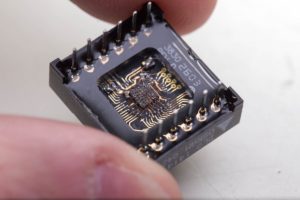Extract Microcontroller PIC18F1230 Code
Extract Microcontroller PIC18F1230 Code from its flash and eeprom memory, then copy microcontroller program and data to other blank MCU PIC18F1230 for the exactly IC cloning, the replication process will normally take several days due to the processing of decapsulation, laser cutting, focus ion beam, etc;

Extract Microcontroller PIC18F1230 Code from its flash and eeprom memory, then copy microcontroller program and data to other blank MCU PIC18F1230 for the exactly IC cloning
14-Bit Power Control PWM Module:
· Up to 6 PWM channel outputs
– Complementary or independent outputs
· Edge or center-aligned operation
· Flexible dead-band generator
· Hardware Fault protection input
· Simultaneous update of duty cycle and period:
– Flexible Special Event Trigger output
Flexible Oscillator Structure:
· Four Crystal modes, up to 40 MHz
· 4x Phase Lock Loop (PLL) – available for crystal and internal oscillators
· Two External RC modes, up to 4 MHz
· Two External Clock modes, up to 40 MHz
· Internal oscillator block:
– 8 user-selectable frequencies from 31 kHz to 8 MHz
– Provides a complete range of clock speeds from 31 kHz to 32 MHz when used with PLL
– User-tunable to compensate for frequency drift
· Secondary oscillator using Timer1 @ 32 kHz
· Fail-Safe Clock Monitor:
– Allows for safe shutdown if peripheral clock stops if read chip pic18f452 program
This document contains device-specific information for the following devices:
· PIC18F1230
· PIC18F1330 range of choices in developing application hardware.
This family offers the advantages of all PIC18 microcontrollers – namely, high computational performance at an economical price – with the addition of high endurance Enhanced Flash program memory.
On top of these features, the PIC18F1230/1330 family introduces design enhancements that make these microcontrollers a logical choice for many high-performance, power control and motor control applications.
Peripheral highlights include:
· 14-bit resolution Power Control PWM module (PCPWM) with programmable dead-time insertion
The PCPWM can generate up to six complementary PWM outputs with dead-band time insertion. Overdrive current is detected by off-chip analog comparators or the digital Fault input (FLTA).
PIC18F1230/1330 devices also feature Flash program memory and an internal RC oscillator after crack mcu pic18f258 software.
New Core Features
nanoWatt TECHNOLOGY
All of the devices in the PIC18F1230/1330 family incorporate a range of features that can significantly reduce power consumption during operation. Key items include:
· Alternate Run Modes: By clocking the controller from the Timer1 source or the internal oscillator block, power consumption during code execution can be reduced by as much as 90%.
· Multiple Idle Modes: The controller can also run with its CPU core disabled but the peripherals still active. In these states, power consumption can be reduced even further, to as little as 4% of normal operation requirements.
· On-the-Fly Mode Switching: The power-managed modes are invoked by user code during operation, allowing the user to incorporate power-saving ideas into their application’s software design.
· Low Consumption in Key Modules: The power requirements for both Timer1 and the Watchdog Timer are minimized. See Section 22.0 “Electrical Characteristics” for values.
Tags: extract microcontroller heximal archive,extract microcontroller heximal code,extract microcontroller heximal content,extract microcontroller heximal data,extract microcontroller heximal eeprom,extract microcontroller heximal file,extract microcontroller heximal firmware,extract microcontroller heximal information,extract microcontroller heximal memory,extract microcontroller heximal program

